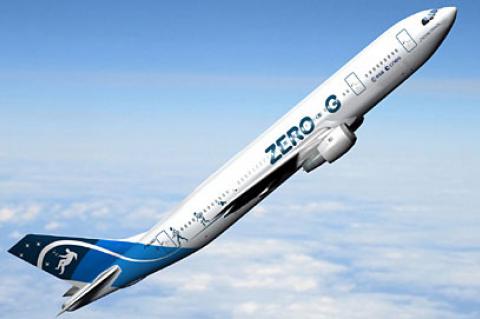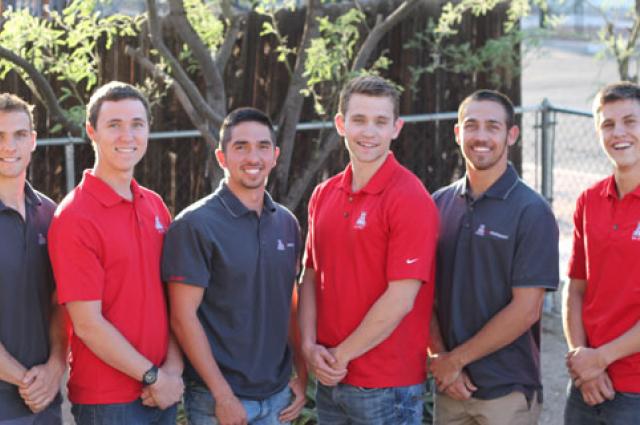High-Flying UA Undergrads to Conduct Microgravity Research Aboard NASA's G Force One
Six UA engineering, math and biology students are getting set to turn somersaults while doing research.

Collectively, the students are the UA Microgravity Research Team and one of 18 U.S. undergraduate teams chosen to participate in NASA’s 2014 Reduced Gravity Student Flight Opportunities Program. Acrobatics aside, their mission is to explore the effects of weightlessness on organic polymer synthesis.
Polymers are large molecules composed of many repeated subunits, called monomers. Naturally occurring examples include starch, cellulose and rubber. Synthetic polymers are used in a wide variety of products, ranging from replacement heart valves to sports helmets.
The team’s research will lay the groundwork for onboard production of polymers for spacecraft repair, the fabrication of insulation for spacesuits, and materials production on long missions.
The UA Microgravity Research Team will join 12 other university teams during a May 30 through June 7 stint at the Johnson Space Center in Houston. (The five other teams conducted their research in April.)
The highlight of their week will be a flight on NASA’s Low-G Flight Research aircraft. This plane -- called G Force One -- flies researchers and their experiments through a series of parabolic flight patterns that top out at 34,000 feet above the Gulf of Mexico and create a weightless environment.
After descending from the apex of a parabola, leveling out and beginning another ascent, humans and their gear are pinned to the floor by double the gravitational force we experience on the Earth’s surface. As the plane pushes over the top of the parabola, weightlessness takes over -- the technical term is microgravity -- and it’s research time.
Microgravity aboard G Force One lasts about 25 seconds, which calls for very efficient experimentation.
“All we have to do is flip a switch,” said aerospace engineering student Ruben Adkins, founder of the Microgravity Research Team. The switch activates a heat gun aimed at test tubes full of organic liquid whose molecules have a structure based on chains of six carbon atoms; gasoline molecules, by comparison, have chains of eight carbon atoms. The heat initiates the polymerization process and turns the liquid six-carbon monomers into a solid foam polymer made up of carbon chains thousands of atoms long.
The UA team’s experiments are expected to help find answers to as yet unanswered questions. For example, is tensile strength improved in polymers that are fabricated in microgravity? What happens to density? Thermal resistance? Impact strength? The team has already conducted experiments here on Earth to determine the properties of the foam polymer created at normal gravity. When they return, they will conduct the same experiments on the foam created under microgravity aboard G Force One and compare results to see how different gravities affect the polymer’s properties.
“We're working in an area that hasn’t been quantified before,” Adkins said.
The UA team has 26 tests planned; the plane is expected to fly as many as 35 parabolas. In addition to their work, students will enjoy a G Force One tradition: weightless playtime.
The gleeful somersaults, back flips, and walks across the ceiling of the cabin last for only a few seconds. Then it’s back to the padded floor for another 2 g descent and ascent.
The steep ascents and descents -- with weightless interludes -- can wreak havoc on the digestive system. Hence the plane’s nickname: the Vomit Comet. All passenger flight suits have an airsickness bag tucked into the breast pocket. Unlucky users get belted into a seat for the remainder of the flight.
Before they leave campus, Adkins and the team will finish building their experimental test rig. After they arrive in Houston, they’ll undergo physiological training, which will be followed by their session aboard G Force One. After the flight, the Microgravity Research Team will analyze data and prepare a report. They’re also planning educational outreach programs for Arizona schools.
Top picture
The UA Microgravity Research Team, from left: Ruben Adkins, aerospace engineering; Dustin Groff, chemical engineering, Michael McCabe, mechanical engineering, Justin Hacnik, molecular and cellular biology; Andrew Jimenez, chemical engineering; and Kellin Rumsey, mathematics, computer science, and chemical engineering.
The UA Microgravity Research Team is sponsored by Ara Arabyan, associate professor and associate head of undergraduate studies, aerospace and mechanical engineering, and coordinator of the Interdisciplinary Engineering Design Program; James A. Field, chair of chemical and environmental engineering; Jeffrey W. Jacobs, department head and Elwin G. Wood Distinguished Professor, aerospace and mechanical engineering; Jennifer K. Barton, interim vice president for research; Elliott C. Cheu, associate dean, College of Science; and Patricia MacCorquodale, dean, Honors College.


